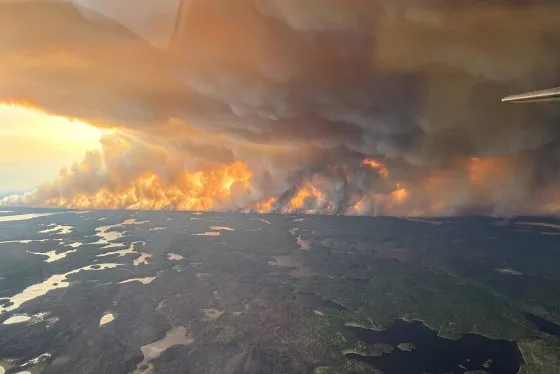Wildfire Smoke Map: A Looming Threat from Canadian Wildfires
The summer of 2023 has proven to be one of the most challenging years for air quality in North America. Wildfires raging across Canada, particularly in the provinces of Manitoba and Saskatchewan, have sent thick plumes of smoke cascading southward into the United States, affecting air quality across the Midwest and Plains. This article covers current wildfire activity, air quality alerts, and the eerie atmospheric phenomena that have been reported due to the smoke.
The Scale of the Outbreak
As of October 2023, the North American fire season has reached alarming levels, with major wildfires erupting due to prolonged droughts, heat waves, and high winds. According to the Canadian Interagency Forest Fire Centre, thousands of hectares have burned, creating smoke that travels vast distances. Previous estimates suggest that approximately 500 wildfires, fueled by dry conditions, have contributed to this troubling scenario.
Wildfire Smoke Mapping
Real-time wildfire smoke maps have become critical for tracking the progress and impact of these fires. Organizations like the National Interagency Fire Center and NOAA provide interactive maps showing smoke dispersion across the Midwest. Residents are urged to check these maps to stay updated on the air quality and recognize when protective measures are necessary.
Air Quality Alerts in the Midwest and Plains
As smoke from Canadian wildfires drifts across the northern United States, the EPA has issued air quality alerts for several states, including Minnesota, Iowa, Wisconsin, and Nebraska. These alerts indicate that air quality has dropped to unhealthy levels due to the presence of particulate matter (PM2.5) in the air.
Exposure to such high levels of air pollution can lead to a range of health problems, particularly for susceptible populations like children, the elderly, and those with pre-existing respiratory conditions.
Advice for Residents
Officials recommend that residents take precautions during this time:
- Stay indoors, especially during peak smoke hours.
- Use air purifiers to filter indoor air where available.
- Avoid outdoor activities and exercise.
- Keep windows closed to prevent smoke intrusion.
- Stay informed through reliable sources about air quality updates.
Understanding the Eerie Phenomenon
On Sunday evening, the sun appeared eerie and surreal to many observers across the Midwest. This optical illusion can be attributed to the smoke particles in the atmosphere. As the sun lowered on the horizon, its light scattered and refracted through the dense smoke, giving it a reddish or orange hue.
Meteorologists explain that when smoke and haze are present in the atmosphere, they can enhance the scattering effects of sunlight, altering the perception of the sun. This phenomenon, often referred to as a ‘smoky sunset,’ has been seen in various parts of the country throughout this wildfire season.
Ask the Meteorologist: Why Did the Sun Look Eerie on Sunday Evening?
To understand the science behind these eerie sunsets, we reached out to meteorologist Dr. Michael Johnson:
Interviewer: Doctor, can you explain why the sun looked so unusual on Sunday evening?
Dr. Johnson: Absolutely. When there are particulates in the atmosphere, such as smoke from wildfires, those particles scatter sunlight in various ways. During sunset or sunrise, when the sun is lower on the horizon, the sunlight has to pass through more of the atmosphere. This means that more of the blue and green wavelengths are scattered out, leaving behind the red, orange, and yellow hues. This is what makes the sun appear so vibrant and unusual when there’s heavy smoke present.
Focus on Canada’s Wildfires in Manitoba and Saskatchewan
The wildfires in Canada predominantly stretch across Manitoba and Saskatchewan, fueled by unusually dry weather conditions and high temperatures recorded throughout the summer. Government officials and ecological experts are closely monitoring these fires due to their potential impact not only on the environment but also on human health and air quality.
Manitoba Wildfires
The province of Manitoba has reported numerous large wildfires, particularly in its northern regions. Home to vast forests, Manitoba’s ecosystem is sensitive, and the fire management teams have been overwhelmed by the rapid spread of blazes. Local authorities have declared a state of emergency in several communities, prompting evacuations and containment efforts.
Saskatchewan’s Response
Likewise, Saskatchewan has been battling some of the fiercest wildfires in its history this summer. The provincial government has implemented immediate fire bans and has mobilized fire crews from across the country to assist in containment efforts. The rapid response is crucial, as the smoke from these fires is a growing public health concern, with many residents experiencing respiratory issues as smoke permeates neighborhoods.
Public Health Impacts
Leading health organizations have sounded the alarm regarding the air quality issues stemming from the wildfires. The Canadian Medical Association and the US Centers for Disease Control and Prevention have released guidance emphasizing the potential health risks associated with wildfire smoke exposure.
Studies show that inhaling fine particulate matter can worsen existing health conditions, such as asthma, and increase the risk of heart problems. Communities across the Midwest and Plains need to remain vigilant, monitoring air quality indexes to safeguard their health.
The Road Ahead: Preparedness and Prevention Strategies
As climate change intensifies, the prevalence and severity of wildfires are expected to rise. This warrants a collective effort in fire preparedness and prevention strategies. Local, state, and federal agencies must enhance their collaborative responses to future wildfire threats and invest in sustainable practices to mitigate risks.
Community Engagement and Education
Community awareness is key to effective wildfire prevention. Educational programs that inform residents about fire risks, safe practices during wildfire events, and recovery strategies will be crucial in safeguarding lives and property. Community drills that simulate evacuation plans could also bolster readiness.
Conclusion
As 2023 draws to a close, the lessons learned from the wildfires in Canada and the subsequent air quality alerts in the Midwest serve as a stark reminder of our vulnerability to environmental changes and the indispensable need for collaboration in disaster response and preparedness. Enhanced mapping technologies and public awareness can help mitigate the impacts of these ongoing crises on public health.
For local updates, check your regional wildfire smoke maps and stay safe as we navigate this unprecedented season of wildfires.







